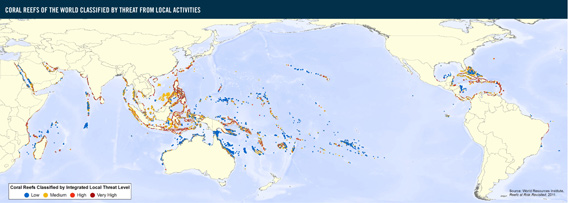海の中で最も生物多様性に富む生態系であるサンゴ礁が深刻な危機に直面していることは、長年海洋科学者達から警告されてきた。しかし、状況はより深刻化している。世界資源研究所(WRI)と他25団体による広範囲にわたる最新の分析では、世界のサンゴ礁の75%が、気候変動を含め地域的または世界的な環境ストレスにより危機状況にあると報告された。1996年に発行された報告書Reefs at Riskを更新した今回の報告書Reefs at Risk Revisitedによれば、サンゴ礁への脅威は30%も増加。過去十年間に行われてきた保全活動は、大規模でのサンゴ礁保全に失敗していることが明らかとなった。
 コスタ川流域の熱帯雨林とサンゴ礁 写真撮影: Rhett A. Butler. |
Reefs at Risk Revisitedによれば、世界のサンゴ礁の60%はすでに乱獲や、サンゴ礁に致命的打撃を与えるダイナマイト漁、陸地からの汚染や海での汚染など、地元による重圧にさらされている。それに加え、世界規模では海水温度の上昇によるサンゴの白化現象、高い二酸化炭素濃度による海洋酸性化という温室効果ガスの排出によって引き起こされる危機にサンゴ礁はさらされているということだ。この地域的、世界的規模で起こる二重の負荷により世界のサンゴ礁の90%が今後20年間で危機的状況に陥るとされ、このままの状況を続ければ2050年には100%近いサンゴ礁が同様の状況に陥ると報告された。
現在、東南アジアのサンゴ礁は最も被害が甚大で、その94%が地元の人為的影響を受けている。
貴重な資源
サンゴ礁は美しいだけでなく、豊かな生態系サービスをもたらしている。海岸線がサンゴ礁に取り囲まれていることによって津波や台風などの高波浪は砕波され、そして海岸浸食などの海岸災害から陸地を保護している。豊かな食料も確保し、海洋生物の4分の1に生息地を提供している。ガンやエイズなどの難病の医薬品もサンゴ種から発見されている。
Reefs at Riskでは、サンゴ礁の損失から生じる経済的および社会的問題に最も悪影響を受けると想定された9カ国をあげている。ハイチ、グレナダ、フィリピン、コモロ、バヌアツ、タンザニア、キリバス、フィジーそしてインドネシアだ。
 グレートバリアリーフ オーストラリア |
保護下のサンゴ礁の現状
すでに世界のサンゴ礁の4分の1が何らかの保護下に置かれているが、その多くが書類上保護を約束されているだけに過ぎず、実際の管理は十分とは言えない。報告書によれば、よく管理の行き届いた海洋保護区内に生息するサンゴ礁は世界のサンゴ礁のうち6%という。
Reefs at Risk Revisitedでは、サンゴ礁を次世代に残すためにどのような対策をたてるべきか提言も行っている。
各地域ごとに、乱獲やダイナマイト漁は廃止される必要があり、沿岸開発は環境へのダメージをよく考慮した上で進め、海水汚染の減少も取り組まれる必要がある。そしてこれらに加え、海洋保護区を拡大し、その管理の改善も求められる。
さらに、サンゴ礁の保護には温室効果ガスの削減を通して気候変動への取り組み
も必要だ。特に、海洋酸性化の原因となっている二酸化炭素の削減が重要である。

地元の脅威レベルによって色分けされたサンゴ礁の分布地図 WRI提供 *地図をクリックすると拡大図が見られます。
当記事は原文記事の抄訳です。
Related articles
Australia’s floods threaten Great Barrier Reef
(01/18/2011) The floods ransacking the Queensland coast have cost 20 lives and $500 million worth of property damage. Now, huge volumes of water are pouring into the ocean, threatening the Great Barrier Reef, which extends for thousands of kilometers off the coast. Although it may take years to know the full consequences of the flooding, Australian scientists are already warning of serious damage. For now, the biggest problems are concentrated on the southern part of the reef, where three overflowing rivers—the Burdekin, the Fitzroy, and the Burnett—have released millions of gallons of heavily polluted water into the sea. So far, prevailing winds have confined the majority of the floodwaters to within 65 kilometers of shore. But in time, the damage may grow to affect the entire reef system.
Photos: Scientists race to protect world’s most endangered corals
(01/11/2011) As corals around the world disappear at alarming rates, scientists are racing to protect the ones they can. At a workshop led by the Zoological Society of London (ZSL), the world’s foremost coral experts met in response to a decade of unprecedented reef destruction to identify and develop conservation plans for the ten most critically endangered coral species.
Atlantic ocean warming confirmed by corals
(01/05/2011) A new study investigating the ability of coral to record sea temperatures indicates that the Northwestern Atlantic has experienced unprecedented warming during the past 150 years.